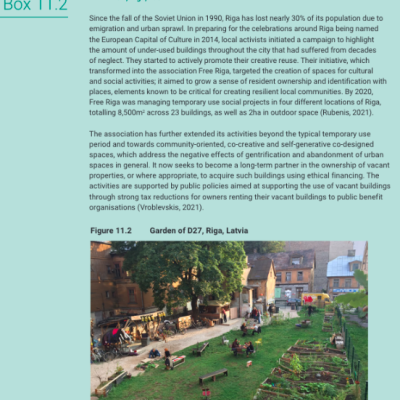Subscribe to our joint NEWSLETTER for
EUTROPIAN &
COOPERATIVE CITY MAGAZINE

Most Europeans live in urban areas and cities play a key role in protecting citizens and improving the resilience of European societies against the increasing impacts of climate change. The European Environment Agency’s report takes stock of urban adaptation in Europe, showcasing what actions cities are taking in response to increasing climate risks, and what is already working.
As European cities increasingly feel the impacts of climate change, such as heatwaves and floods, there is a clear case for investing in urban societal resilience, the EEA report states. Cities have an essential role in the implementation of adaptation actions, which need to take into account local conditions and specific vulnerabilities.
European cities are adapting to climate change through a wide range of effective actions, including urban planning and building codes, economic incentives and insurance, early-warning systems and information campaigns. Emerging areas of opportunity for adaptation include promoting urban agriculture, creating more liveable public spaces and protecting cultural heritage

The report features Free Riga, a case explored in Cooperative City’s publication “The Power of Civic Ecosystems” and in the article “Free Riga: a platform for temporary use.” Free Riga is used in one of the spotlight chapter European Environment Agency report as an example of urban climate change adaptation.
Free Riga is an organisation promoting the temporary use of vacant and underused buildings across the city of Riga. Founded in 2013, Free Riga gained exposure through a highly successful campaign to make visible the hundreds of empty buildings that suffered from decades of neglect. Since then, the organisation operates as a platform to help the owners of vacant properties by opening their buildings to potential users, thus bringing cultural life in different parts of Riga.
They are also increasingly implementing nature-based solutions, which are included in 91% of local adaptation plans analysed in the report. Nature-based solutions are effective for cooling and water retention in cities, and they also provide many other benefits, such as space for recreation and reducing pollution. However, due to the magnitude of expected climate impacts, it may still be necessary to combine nature-based approaches with other types of actions, including physical infrastructure, the EEA report notes.
The EEA report highlights several enabling conditions for successful adaptation. These include sustained political commitment that is often linked to adequate long-term funding, good governance and engagement of local citizens, learning from other cities and knowledge-based decision making.
The report highlights that adaptation is required across all sectors and at all governance levels, and that actions will need to both address current climate impacts and protect against greater, future risks. The EEA report also stresses that if actions taken at the local level are to be properly upscaled, much more tangible targets are needed to measure progress. Currently, only 2% of indicators used for monitoring in local adaptation plans are linked to a specific adaptation target.
In March, the EEA published the first ever European climate risk assessment, showing that Europe’s current policies and adaptation actions are not keeping pace with the rapidly growing climate risks. According to the report, densely-populated, urban areas are at particular risk from heatwaves and extreme precipitation.

| Cookie | Duration | Description |
|---|---|---|
| cookielawinfo-checkbox-analytics | 11 months | This cookie is set by GDPR Cookie Consent plugin. The cookie is used to store the user consent for the cookies in the category "Analytics". |
| cookielawinfo-checkbox-functional | 11 months | The cookie is set by GDPR cookie consent to record the user consent for the cookies in the category "Functional". |
| cookielawinfo-checkbox-necessary | 11 months | This cookie is set by GDPR Cookie Consent plugin. The cookies is used to store the user consent for the cookies in the category "Necessary". |
| cookielawinfo-checkbox-others | 11 months | This cookie is set by GDPR Cookie Consent plugin. The cookie is used to store the user consent for the cookies in the category "Other. |
| cookielawinfo-checkbox-performance | 11 months | This cookie is set by GDPR Cookie Consent plugin. The cookie is used to store the user consent for the cookies in the category "Performance". |
| viewed_cookie_policy | 11 months | The cookie is set by the GDPR Cookie Consent plugin and is used to store whether or not user has consented to the use of cookies. It does not store any personal data. |
